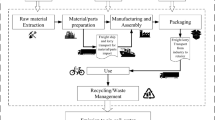Abstract
Life-cycle assessment (LCA) is environmental evaluation of products, materials, and processes over their life cycle. Truncation uncertainty and corresponding uncertainty are main problems occurred in process life cycle assessment (PLCA) modeling and economic input-output life cycle assessment (EIOLCA) modeling. Through combination of these two modelings in different life cycle stage and use of an uncertainty reduction strategy, a hybrid life cycle assessment modeling method was proposed in this study. Case studies were presented on gasoline-powered motorbikes (M-bike) and electricity-powered electric bike (E-bike). Web-based software was developed to analyze process environmental impacts. Results show that the largest part of life cycle energy (LCE) is consumed at use stage. Less energy is consumed in life cycle of E-bike than that of M-bike. GWP (Global Warming Potential), CO (Carbon Monoxide), PM10 (particulate matter) emission of M-bike are higher than that of E-bike, especially at use stage, AP (acidification Potential) emission of E-bike is higher than that of M-bike. Comprehensively, E-bike is energy efficient and less emitting, and better choice for urban private transportation.
Similar content being viewed by others
References
Maurice B, Frischknecht R, Coelho-Schwirtz V, et al. Uncertainty analysis in life cycle inventory: application to the production of electricity with French coal power plants[J]. Journal of Cleaner Production, 2000, 8: 95–108.
Heather L, MacLean, Lave L B. Evaluating automobile fuel/propulsion system technologies[J]. Progress in Energy and Combustion Science, 2003, 29: 1–69.
Lave L B, Cobas-Flores E, Hendrickson C T, et al. Using input-output analysis to estimate economy-wide discharges[J]. Environmental Science and Technology, 1999, 29: 420A-426A.
Azapagic A. Life cycle assessment and its application to process selection, design and optimisation [J]. Chemical Engineering Journal, 1999, 73: 1–21.
Nielsen A M, Weidema B P. Input/output analysis-Shortcuts to life cycle data[R]. Copenhagen, Denmark: Danish Environmental Protection Agency, 2001.
Jacquetta J, Lee P, O’Callaghan, et al. Critical review of life cycle analysis and assessment techniques and their application to commercial activities[J]. Resources, Conservation and Recycling, 1995, 13: 37–56.
ISO 14040. Environmental Management-life Cycle Assessment-principles and Framework[S].
Guinee J B. Handbook on Life Cycle Assessment[M]. New York: Kluwer Academic Press, 2002.
Todd J A T. Streamlined Life-Cycle Assessment: A Final Report from the SETAC[R]. Belgium: The Society of Environmental Toxicology and Chemistry, 1999.
Joshi S, Lansing E. Product environmental life-cycle assessment using input-output techniques[J]. Journal of Industrial Ecology, 2002, 3: 95–118.
Treloar G J. Extracting embodied energy paths from input-output tables: towards an input-output-based hybrid energy analysis method[J]. Economic Systems Research, 1997, 4: 375–378.
Department of National Accounts, National Statistics Bureau of China. Input-output Table[M]. Beijing: China Statistics Press, 1999.
National Bureau of Statistics of China. China Statistical Yearbook[M]. Beijing: China Statistics Press, 2004.
GB/T4754-94, National Economic Sector Classification and Codes[S].
Wang M Q. GREET 1.5-Transportation Fuel-Cycle Model Volume 1: Methodology, Development, Use, and Results[R]. Dearborn, USA: Agronne Information and Publishing Division, 1999.
National Environmental Protection Bureau. Handbook for Industrial Pollutants and Emission Factors [M]. Beijing: China Environmental Science Press, 1996. 10–28.
Author information
Authors and Affiliations
Corresponding author
Additional information
Foundation item: Project (G-0205-06347) supported by David and Lucile Packard Foundation in Partnership with the US Energy Foundation; Project (ICA4-2002-10023) supported by European Union
Rights and permissions
About this article
Cite this article
Dai, D., Leng, Rb., Zhang, C. et al. Using hybrid modeling for life cycle assessment of motor bike and electric bike. J Cent. South Univ. Technol. 12, 77–80 (2005). https://doi.org/10.1007/s11771-005-0014-0
Received:
Accepted:
Issue Date:
DOI: https://doi.org/10.1007/s11771-005-0014-0




